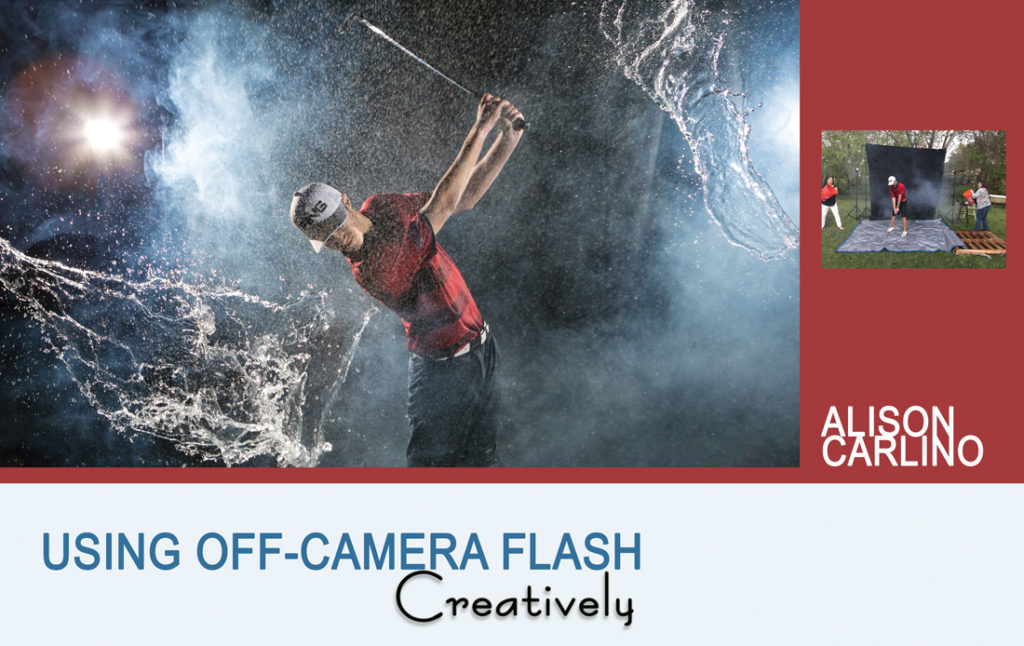Although I have been using OCF (off-camera flash) for many years, there was a time in the beginning of my career that it terrified me. I had no idea what it could offer my images, had no training, and very little budget to purchase gear. About year five of my career, I finally got frustrated enough that I couldn’t produce those dark dramatic clouds or light a reception room they way I had seen others do. I knew it was time to learn the “f” word. This is year 14 and I wouldn’t shoot without it on a portrait session and definitely not on a wedding day. It has truly helped to define my bold color/dramatic lighting style that I now teach around the world.
Think about drawing with light as a painter would, visualizing the final scene in your mind. Work backwards to create it, adding OCF where needed to highlight the areas you want the viewer to see first. Diagnosing the quality, quantity, and color of the ambient light is key to knowing if you need to add or subtract from the scene. If you know how to control your exposure, you can “drown out” a scene and then use OCF to paint back and create what your mind sees. What do the shadows have to offer you? What color is the existing light or what do you want to change it to? Is the light punchy and harsh enough for your vision or perhaps you’re imagining something softer and sweeter. A lot of people don’t realize that flash exposure and ambient exposure are separate manual settings you’ll dial in but in the end, they merge together to create your final vision.
I prefer to walk the scene and diagnose it first. One of the techniques you’ll often see me do is raise my hand and look at the way the light, shadows, and color falls on both sides (palm and back of hand). Then, I think about what needs to be done to modify the light to match my vision. I think about how I will compose the image. What angle will I shoot from? What lens to use? I typically find the ambient light exposure first. If I have an assistant with me, I will ask them to stand in as I proceed through my steps. Once you have these basic steps down, OCF can be seen as a creative and a corrective tool. Following are a few ideas to share with you to freshen up your OCF.
Idea 1 – Rim lighting with the addition of water or fog: The image of the golfer (above) screams “Alison Carlino!” I love the drama of a backlit image using anything that can give me water… sprinklers, spray bottles, fountains, and of course, real rain. Add a fog machine and a colored gel and you’ve got major social media traffic talking about you. I place the flash about 6 to 8 feet behind the subject and use their bodies to block the light head. If your subjects move, you’ll likely experience flare back into your lens (which could work too). Water images aren’t just done at night; I find fountains often on engagement or portrait shoots and when flash is added, it produces an extra layer of separation. Be sure to use your flash’s zoom feature or a grid to control the spill of light on the scene. Want to separate yourself from the natural light shooters? Backlighting a subject and adding water or fog is one way to do it.
Idea 3 – Using color to your advantage: Whether it’s white balance settings that you change in camera or gels that you add to your flash, color has so many possibilities. Rogue is my supplier of choice for gels. I use ½ and full CTO gels to correct very warm colored venues but I also use them when I want to increase the volume of blue. If you set your in camera Kelvin temperature to correct for the warmness and also place a CTO gel on the flash, you can control exactly how “cool” your scene will become. If you like the orange hot spot behind your couple, place a full CTO on your speedlight, turn it towards the wall behind them, and change your white balance to the tungsten light bulb. Be sure to control the angle of the flash
Idea 4 – Shutter drag with subjects frozen: Although it’s somewhat hard to wrap your mind around this (images below), you can handhold the camera at slower shutter speeds and still get a frozen image of your couple because flash saves the day!
Idea 5 – Finding a creeper viewpoint: Sounds strange, I know, but framing up your subject using surroundings that tell the story and pumping the flash in while you stand outside the scene is great way to draw the viewer’s eye straight to what you want them to look at. It really does help to have an assistant here because you might be far away and need the stand moved. Recently, I had an outdoor senior session near sunset. I walked her property and identified the areas where the sun could work as the backlight. I then placed the girl in poses she could handle, set up the flash in my triangle lighting pattern (45 degrees left or right from the subject), and then positioned myself where a metal bar created a triangle around her face. It feels like you are a creeper in the grass but you do what it takes to get the shot!
Alison Carlino will be teaching a class at the 2021 Texas School of Professional Photography.
Alison Carlino has 17 years in the industry and has seen the trends come/go. In this class, you will learn lighting off camera, modern posing, and the collections/products that have made her senior portrait & sports business wildly successful. Expect very little lecture and a lot of hands on.
